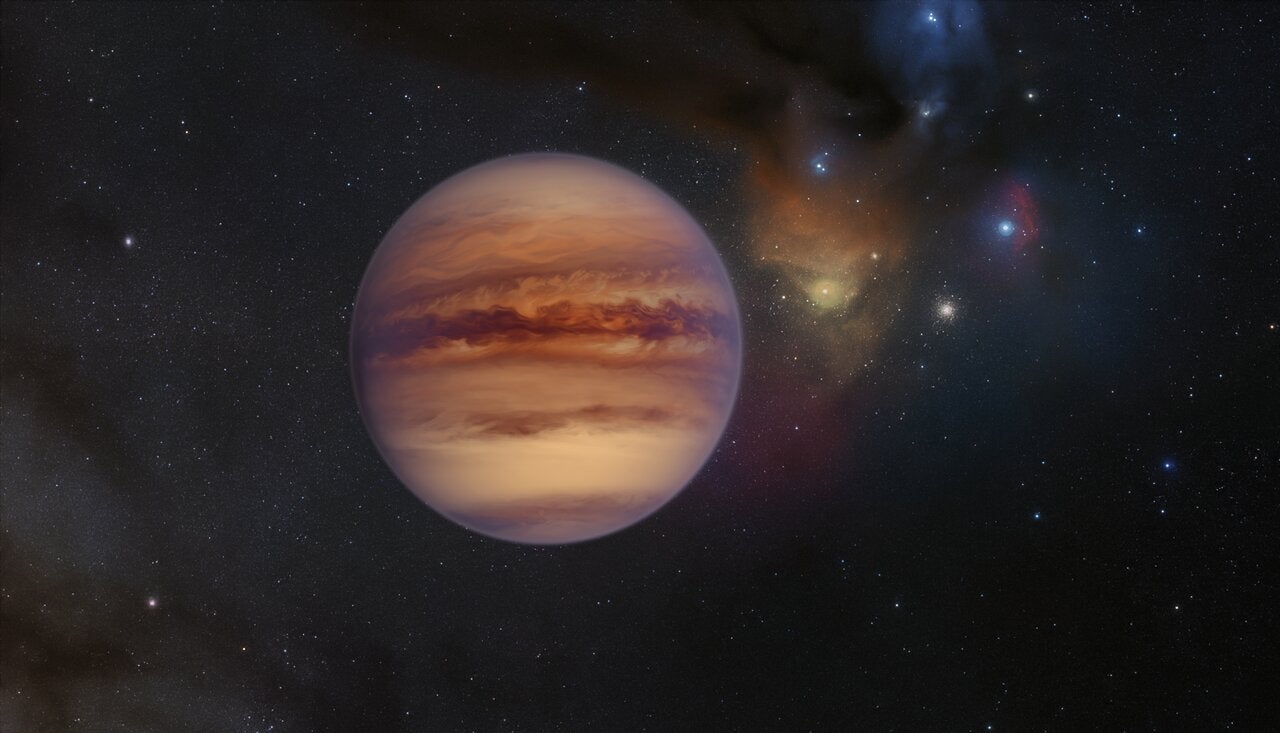An international collaboration of astronomers is reporting on the discovery of between 70 and 170 rogue planets, in what is an unprecedented scientific achievement.
Rogue planets are as creepy as they are mysterious. Floating through the dark expanse of interstellar space, these planets are without host stars, having either departed their star system of origin or never having a star system of origin in the first place. Astronomers first learned about free-floating planets in the 1990s, but many unanswered questions remain, such as the conditions under which they form, their size and composition, and their relative abundance in the galaxy.
Research published today in Nature is moving the needle forward on these astronomical matters, as a team of scientists has spotted upwards of 170 rogue planets in a nearby region of the Milky Way known as the Upper Scorpius OB stellar association (by “nearby” we’re talking about 420 light years away). This effectively doubles the total number of known free-floating planets — a sign that the total population of rogue planets in our galaxy is huge. Indeed, the total number of rogue planets suspected of lurking in the Milky Way would’ve made the late Carl Sagan very proud, as it likely numbers in the billions and billions — and possibly in the trillions.
The newly detected rogue planets were detected in nearly 20 years’ worth of astronomical data, including observations gathered by the European Southern Observatory, the Canada-France-Hawaii Telescope, the Subaru Telescope, and ESA’s Gaia satellite. Hervé Bouy, an astronomer at the University of Bordeaux and the project leader, said data made available through the extensive NOIRLab Astro Data Archive was “fundamental to this study,” as he explained in a NOIRLab statement.

In an email, Núria Miret-Roig, an astronomer at the University of Bordeaux and the first author of the new study, said the new work covers an “extremely large area in the sky,” approximately 170 degrees square, which is much larger than previous surveys. “This has been possible thanks to the compilation of all the images available in public archives together with our own observations,” she said. The tremendous amount of data — 80,000 images totaling 100 TB — required the team “to combine modern statistical tools with data mining techniques.”
A key aspect of the study was the technique used for spotting rogue planets. Detecting free-floating planets is challenging, as they’re not associated with a host star and it’s not immediately obvious where they’re located in the vastness of space. The traditional approach to detecting rogue planets, microlensing, depends on chance alignments between a rogue planet and an unrelated background star. The problem with microlensing is that they tend to be one-off events, and the rogue planet is likely to never be seen again. The inability to study an exoplanet for an extended period of time represents a huge limitation.
An exciting aspect of the new study is that the newly detected rogue planets can be studied in the future. Miret-Roig and her colleagues worked under the assumption that some rogue planets, having formed only a few million years ago, are still piping hot, and as such are directly detectable by telescopes. For the study, the team pored over those 80,000 wide-field images, measuring the light across a range of optical and near-infrared wavelengths. The team also measured the tiny motions made by the objects, which they did to further re-affirm them as planets zipping around space without hosts.
As many as 3,455 candidates were identified, of which 70 to 170 Jupiter-size objects were deemed to be true rogue exoplanets. The astronomers could not pinpoint an exact number due to uncertainties having to do with the presumed age of the region and the mass of the objects.
“We were able to infer individual masses by comparing the brightness of each planet with theoretical models. The main difficulty is that planets are relatively bright when they are young and they quickly fade with time,” explained Miret-Roig. “Then, if the age of the planet is not precisely known — which is the case in our sample — it is hard to differentiate an old massive planet from a younger but less massive one.”
A follow-up study to measure the precise age and mass of these presumed rogue exoplanets is planned, as are some spectroscopic observations to “determine other physical properties such as the effective temperature and the composition,” she said. Future observatories, such as with the upcoming Webb space telescope, the Extremely Large Telescope (ELT), and Vera C. Rubin Observatory, could further validate these results.
Another exciting aspect of this study is what it’s telling us about the conditions under which rogue planets form. Two theories aim to explain how planets like this come into existence. They either form from protoplanetary disks around host stars and then get booted out into interstellar space, or they form from the collapse of gas clouds that are too small to form stars.
Miret-Roig said the total number of stray objects observed in the new study “exceeds the number of free-floating planets expected if they only form like stars from the collapse of a small molecular cloud, indicating that other mechanisms must be at play.” Astronomers, therefore, “can say that both mechanisms must be at work, and that the contribution of ejections to the final population must be significant.”
Given that rogue planets are likely produced by both processes, the total number of rogue planets should be huge. Like Carl Sagan huge. Thanks to those upcoming follow-up studies and future telescopes, we should expect to learn a lot more in the coming years.
